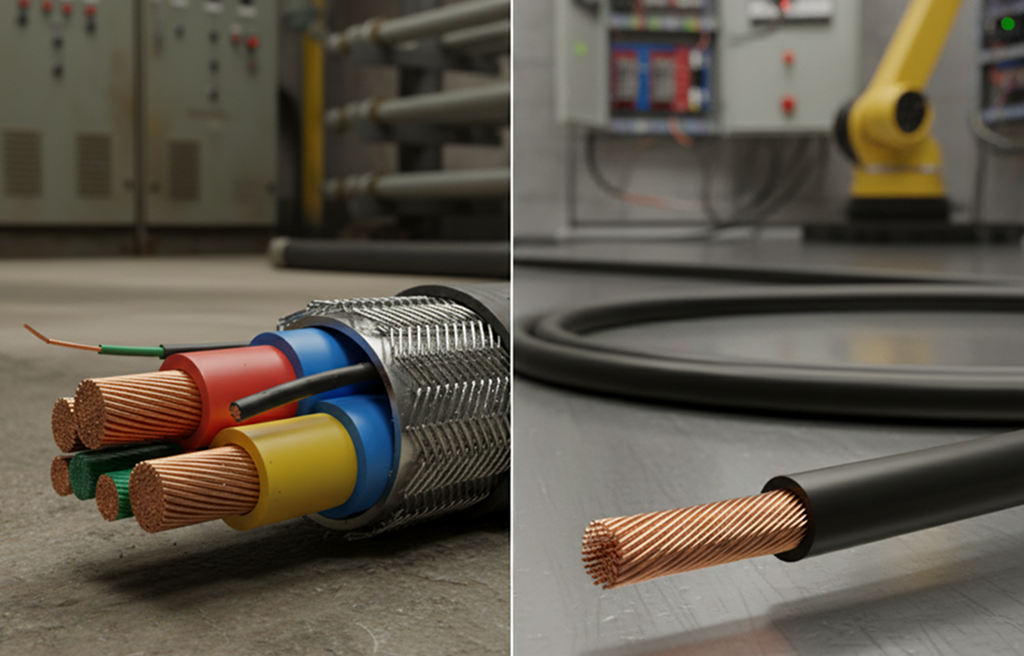Armoured cables and flexible cables are both essential in electrical installations, but they serve very different purposes. One offers protection and strength. The other gives you flexibility and movement. Knowing which one to choose can save you time, money, and potential site issues.
This guide breaks down the key differences between armoured cables and flexible cable, including when to use a flexible armoured cable for added adaptability without sacrificing durability.
Table of Contents
- What Are Armoured Cables?
- What Are Flexible Cables?
- Armoured Cables vs Flexible Cable: Comparison Table
- Key Differences Explained
- Which Cable Type Should You Use?
- Conclusion
What Are Armoured Cables?
Armoured cables are designed for strength and protection. They feature a metal layer, typically steel wire or tape, wrapped around the inner cores. This shielding protects the cable against mechanical damage, external impact, pressure, and even rodents.
You’ll typically find an armoured power cable used in:
- Underground installations
- External power feeds
- Industrial environments
- Harsh or high-traffic areas
Because they’re rugged and secure, armoured cables are ideal for permanent installations where reliability matters.
What Are Flexible Cables?
Flexible cables are built for movement. Their inner conductors are made from finely stranded copper, and their outer sheaths are soft and pliable. This makes routing easy, especially around tight corners or inside equipment.
They’re commonly used in:
- Portable appliances
- Control panels
- Lighting rigs
- Moving machinery
Unlike armoured cables, flexible cable is not designed to take physical punishment or environmental pressure. But it shines in applications where mobility or frequent bending is required.
Armoured Cables vs Flexible Cable: Comparison Table
Here’s a side-by-side look at how the two cable types compare:
| Feature | Armoured Cables | Flexible Cables |
| Construction | Steel wire/tape for protection | Fine-stranded copper with soft sheath |
| Flexibility | Low – rigid and fixed | High – ideal for movement |
| Protection Level | Excellent against impact, pressure, rodents | Minimal physical protection |
| Best Used For | Underground, industrial, external power feeds | Portable tools, short-term or mobile setups |
| Installation Type | Fixed, permanent | Temporary, movable |
| Cost | Higher due to armouring | Lower and more budget-friendly |
Key Differences Explained
1. Construction
An armoured cable includes a steel or aluminium armouring layer between its insulation and sheath. This creates a barrier that absorbs shock and resists crushing.
A flexible cable, on the other hand, uses thin copper strands and soft insulation. There’s no armouring, it’s all about bendability and ease of handling.
2. Flexibility
If your installation needs movement, flexible cable is the clear winner. It can bend, twist, and flex without damage. Perfect for machinery or temporary power.
Armoured cables are far more rigid. They don’t bend easily and are designed for static positions. Attempting to use them in moving systems could cause stress fractures over time.
3. Protection and Durability
This is where armoured cables excel. The steel armouring shields the conductors from crushing, rodents, or accidental impact. You can bury them underground or run them across open outdoor areas with confidence.
In contrast, flexible cables should only be used where there’s little to no risk of physical damage.
4. Application and Use Cases
Use armoured cables for:
- Power supply in buildings
- External lighting systems
- Underground wiring
- Industrial automation setups
Use flexible cables for:
- Extension cords
- Portable lighting
- Control wiring in panels
- Internal machinery components
If you need both protection and some movement, a flexible armoured cable is a smart compromise. It adds a braided steel layer for light protection while retaining flexibility.
5. Installation and Cost
Armoured power cable usually costs more due to materials and weight. It also takes longer to install, as you’ll need specific glands and earthing.
Flexible cable is lighter, cheaper, and quicker to set up. But you must be sure it’s only used in safe, low-risk environments.
Which Cable Type Should You Use?
Choosing between armoured and flexible cable depends on the demands of your project:
- Pick armoured cables if the cable will be exposed to physical stress, buried underground, or installed outdoors.
- Go with flexible cable for ease of movement and fast installations where protection isn’t a concern.
- Use flexible armoured cable if you need both light protection and limited flexibility.
Still not sure? The team at Batt Cables is here to help match the right cable to your exact requirements.
Conclusion
Both armoured cables and flexible cables have their place in electrical installations. If you need strength, go with an armoured power cable. If you need mobility, choose a flexible cable. And if you need a bit of both, consider a flexible armoured cable for the best of both worlds.
Remember, choosing the right cable helps reduce risk, improve performance, and extend the lifespan of your installation.




